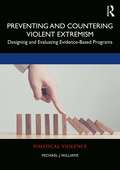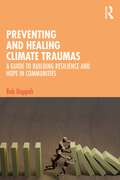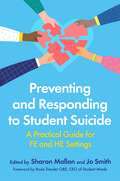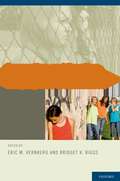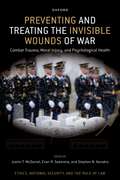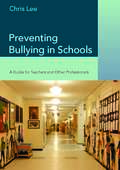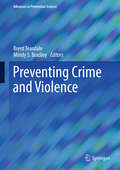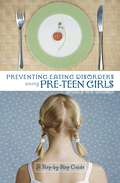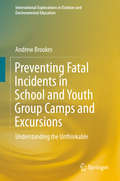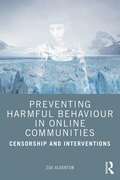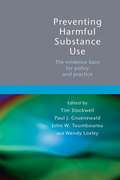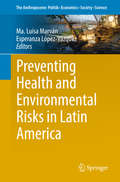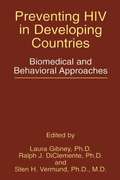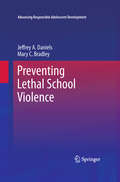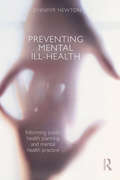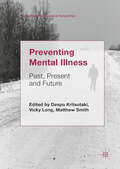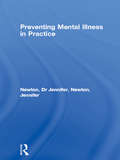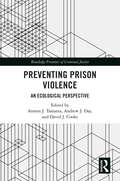- Table View
- List View
Preventing and Countering Violent Extremism: Designing and Evaluating Evidence-Based Programs (Political Violence)
by Michael J. WilliamsThis textbook serves as a guide to design and evaluate evidence-based programs intended to prevent or counter violent extremism (P/CVE). Violent extremism and related hate crimes are problems which confront societies in virtually every region of the world; this text examines how we can prevent or counter violent extremism using a systematic, evidence-based approach. The book, equal parts theoretical, methodological and applied, represents the first science-based guide for understanding “what makes hate,” and how to design and evaluate programs intended to prevent this. Though designed to serve as a primary course textbook, the work can readily serve as a how-to guide for self-study, given its abundant links to freely available online toolkits and templates. As such, it is designed to inform both students and practitioners alike with respect to the management, design, or evaluation of programs intended to prevent or counter violent extremism. Written by a leading social scientist in the field of P/CVE program evaluation, this book is rich in both scientific rigor and examples from the “real world” of research and evaluation dedicated to P/CVE. This book will be essential reading for students of terrorism, preventing or countering violent extremism, political violence, and deradicalization, and highly recommended for students of criminal justice, criminology, and behavioural psychology.
Preventing and Countering Violent Extremism: Designing and Evaluating Evidence-Based Programs (Political Violence)
by Michael J. WilliamsThis textbook serves as a guide to design and evaluate evidence-based programs intended to prevent or counter violent extremism (P/CVE). Violent extremism and related hate crimes are problems which confront societies in virtually every region of the world; this text examines how we can prevent or counter violent extremism using a systematic, evidence-based approach. The book, equal parts theoretical, methodological and applied, represents the first science-based guide for understanding “what makes hate,” and how to design and evaluate programs intended to prevent this. Though designed to serve as a primary course textbook, the work can readily serve as a how-to guide for self-study, given its abundant links to freely available online toolkits and templates. As such, it is designed to inform both students and practitioners alike with respect to the management, design, or evaluation of programs intended to prevent or counter violent extremism. Written by a leading social scientist in the field of P/CVE program evaluation, this book is rich in both scientific rigor and examples from the “real world” of research and evaluation dedicated to P/CVE. This book will be essential reading for students of terrorism, preventing or countering violent extremism, political violence, and deradicalization, and highly recommended for students of criminal justice, criminology, and behavioural psychology.
Preventing and Healing Climate Traumas: A Guide to Building Resilience and Hope in Communities
by Bob DoppeltUsing extensive research, interviews with program leaders, and examples, Preventing and Healing Climate Traumas is a step-by-step guide for organizing community-based, culturally tailored, population-level mental wellness and resilience-building initiatives to prevent and heal individual and collective climate traumas. This book describes how to use a public health approach to build universal capacity for mental wellness and transformational resilience by engaging community members in building robust social support networks, making a just transition by regenerating local physical/built, economic, and ecological systems, learning how trauma and toxic stress can affect their body, mind, and emotions as well as age and culturally tailored mental wellness and resilience skills, and organizing group and community-minded events that help residents heal their traumas. These actions build community cohesion and efficacy as residents also engage in solutions to the climate emergency. This book is essential reading for grassroots, civic, non-profit, private, and public sector mental health, human services, disaster management, climate, faith, education, and other professionals, as well as members of the public concerned about these issues. Readers will come away from this book with practical methods—based on real-world examples—that they can use to organize and facilitate community-based initiatives that prevent and heal mental health and psycho-social-spiritual problems and reduce contributions to the climate crisis.
Preventing and Healing Climate Traumas: A Guide to Building Resilience and Hope in Communities
by Bob DoppeltUsing extensive research, interviews with program leaders, and examples, Preventing and Healing Climate Traumas is a step-by-step guide for organizing community-based, culturally tailored, population-level mental wellness and resilience-building initiatives to prevent and heal individual and collective climate traumas. This book describes how to use a public health approach to build universal capacity for mental wellness and transformational resilience by engaging community members in building robust social support networks, making a just transition by regenerating local physical/built, economic, and ecological systems, learning how trauma and toxic stress can affect their body, mind, and emotions as well as age and culturally tailored mental wellness and resilience skills, and organizing group and community-minded events that help residents heal their traumas. These actions build community cohesion and efficacy as residents also engage in solutions to the climate emergency. This book is essential reading for grassroots, civic, non-profit, private, and public sector mental health, human services, disaster management, climate, faith, education, and other professionals, as well as members of the public concerned about these issues. Readers will come away from this book with practical methods—based on real-world examples—that they can use to organize and facilitate community-based initiatives that prevent and heal mental health and psycho-social-spiritual problems and reduce contributions to the climate crisis.
Preventing and Responding to Student Suicide: A Practical Guide for FE and HE Settings
by Sharon Mallon Jo Smith Rosie Tressler ObeThis practical book covers issues related to suicide risk, prevention and postvention in Higher and Further Education communities. Compiled by 37 experts, it is an authoritative guide to an issue that is causing increasingly large concern for FE and HE institutions and covers multiple evidence-backed approaches with a pragmatic focus. It is the first that specifically deals with student suicide in FE Colleges and universities, encouraging a holistic, institutional response. Chapters are split into three sections, beginning with understanding and preventing student suicide among students, followed by responses to risk, including a model for student prevention in HE settings. The book concludes with the response to student death by suicide with advice on postvention, and how to support bereaved family, staff, and students.
Preventing and Responding to Student Suicide: A Practical Guide for FE and HE Settings
by Sharon Mallon and Jo SmithThis practical book covers issues related to suicide risk, prevention and postvention in Higher and Further Education communities. Compiled by 37 experts, it is an authoritative guide to an issue that is causing increasingly large concern for FE and HE institutions and covers multiple evidence-backed approaches with a pragmatic focus. It is the first that specifically deals with student suicide in FE Colleges and universities, encouraging a holistic, institutional response. Chapters are split into three sections, beginning with understanding and preventing student suicide among students, followed by responses to risk, including a model for student prevention in HE settings. The book concludes with the response to student death by suicide with advice on postvention, and how to support bereaved family, staff, and students.
Preventing and Treating Bullying and Victimization
by Eric Vernberg Bridget BiggsResearch evidence on bully-victim problems has accumulated rapidly in recent years. From this, there is little doubt that prolonged involvement in bullying, as a perpetrator, victim, or, not uncommonly, as both a perpetrator and target of bullying, conveys risk for many aspects of development. As in many emerging areas of psychological science, diverse research efforts evolved more or less independently, producing a very large and rich body of knowledge, but making it difficult to gain a comprehensive, integrated view of the overall evidence base. Preventing and Treating Bullying and Victimization looks across the sometimes disparate perspectives from school, clinical, and developmental researchers and professionals with an eye towards describing and integrating current knowledge into a guide for evidence-based practices and further research. The authors offer new directions for understanding this complex problem and for enhancing intervention approaches. This edited book is comprised of three sections: Theoretical Perspectives, Assessment and Intervention, and Recommendations for Policy, Practice, and Research. It is of interest to a number of professions and disciplines including clinical, developmental, counseling, and school psychologists, social workers, school administrators and educators, and public officials involved in setting policies.
Preventing and Treating the Invisible Wounds of War: Combat Trauma, Moral Injury, and Psychological Health (Ethics, National Security, and the Rule of Law)
by Justin T. McDaniel, Evan R. Seamone, and Stephen N. XenakisThis volume provides several perspectives that help practitioners, advocates, and policymakers understand the impact of historical and recent wars on U.S. Military veterans. The chapters address newly recognized conditions, such as moral injury, military sexual trauma, and remote combat trauma as precursors to more serious diagnosable mental health disorders with the goal of addressing how these conditions can be identified and mitigated in future combat operations. The chapters also provide new insights on calculating the costs of wars in terms of dollars spent on treating mental health conditions, the intergenerational impact of combat trauma on families and future generations, and involvement in the criminal justice system of those who do not receive treatment due to discharge characterizations from military misconduct.
Preventing and Treating the Invisible Wounds of War: Combat Trauma, Moral Injury, and Psychological Health (Ethics, National Security, and the Rule of Law)
This volume provides several perspectives that help practitioners, advocates, and policymakers understand the impact of historical and recent wars on U.S. Military veterans. The chapters address newly recognized conditions, such as moral injury, military sexual trauma, and remote combat trauma as precursors to more serious diagnosable mental health disorders with the goal of addressing how these conditions can be identified and mitigated in future combat operations. The chapters also provide new insights on calculating the costs of wars in terms of dollars spent on treating mental health conditions, the intergenerational impact of combat trauma on families and future generations, and involvement in the criminal justice system of those who do not receive treatment due to discharge characterizations from military misconduct.
Preventing Bullying in Schools: A Guide for Teachers and Other Professionals (PDF)
by Dr Chris Lee`Written from the whole-school perspective on bullying prevention, Chris Lee's book, Preventing Bullying in Schools: A Guide for Teachers and Other Professionals offers a series of activities and discussion points aimed at increasing awareness about bullying and informing school policy and practices. This practical guidebook is aimed primarily for teachers and others working in schools as well as students of education`- Education Review `This is an easily readable book with many interesting and useful ideas and activities; a "must read" for anyone planning staff training on bullying' - Emotional Behavioural Difficulties `The author provides practical advice on how to counter and prevent bullying in schools, suggesting exercises that will promote change. The book would make excellent INSET provision. It includes both classroom-based and staffroom -based activities and is a succinct reference for busy professionals' - Leadership Links (NAHT) `What is admirable about this book is the way it takes a difficult and sometimes intangible issue and shows systematic strategies for dealing with it... This is a welcome book, a skilful mix of practical advice placed in a broader perspective of defining bullying carefully and exploring existing good practice' Geoff Barton, Times Educational Supplement `The book is written in a clear and succinct and meaningful manner and it is vital that his book be in every classroom throughout the UK and most importantly that it is read, understood and followed!' - Dr L F Lowenstein, Educational, Clinical and Forenscic Psychological Consultant `The entire book makes an excellent INSET provision... it should be on all headteachers', senior staff and pastoral leaders' shelves' - David Hall, Assistant Headteacher `Preventing Bullying in Schools is signally important reading for anyone directly or indirectly involved with the creation of a violence-free learning environment for children' - Midwest Book Review and Internet Bookwatch 'Easy to use, informative, and very practical' - Debate Designed to offer teachers, student teachers, teaching assistants and other educational professionals advice on how to counter and prevent bullying in schools, this book suggests classroom-based and staffroom-based activities that will help promote change. Tried and tested strategies are put forward based on the author's school-based research and regular work in schools, training staff who deal with incidents of bullying. Included is advice on: } understanding the terminology } anti-bullying strategies } writing a whole-school policy } generating whole-school responsibility and involvement } useful contacts and organizations. The book shows what can be done to tackle an area of great concern to pupils, teachers and parents and makes powerful and realistic suggestions for ways forward. Chris Lee is a former teacher who now lectures and undertakes research at the University of Plymouth where he runs courses for teachers and teaching assistants.
Preventing Crime and Violence (Advances in Prevention Science)
by Brent Teasdale Mindy S. BradleyThis insightful volume integrates criminological theories, prevention science, and empirical findings to create an up-to-date survey of crime prevention research and strategies. Its interdisciplinary perspective expands on our knowledge of risk factors to isolate the malleable mechanisms that produce criminal outcomes, and can therefore be targeted for intervention. In addition, the text identifies developmental, lifespan, and social areas for effective intervention. Reviews of family-, community-, and criminal justice-based crime prevention approaches not only detail a wide gamut of successful techniques, but also provide evidence for why they succeed. And as an extra research dimension, the book’s chapters on methodological issues and challenges uncover rich possibilities for the next generation of crime prevention studies. Included in the coverage: Integrating criminology and prevention researchSocial disorganization theory: its history and relevance to crime preventionResearch designs in crime and violence preventionMacro- and micro-approaches to crime prevention and intervention programsImplications of life course: approaches for prevention sciencePromising avenues for prevention, including confronting sexual victimization on college campuses Spotlighting current progress and continuing evolution of the field, Preventing Crime and Violence will enhance the work of researchers, practitioners, academicians, and policymakers in public health, prevention science, criminology, and criminal justice, as well as students interested in criminology and criminal justice.
Preventing Eating Disorders among Pre-Teen Girls: A Step-by-Step Guide (Non-ser.)
by Beverly MenassaA must for parents, teachers and counselors, this book targets preadolescent girls aiming to engage them in educational activites that will empower them to avoid eating disorders. The author examines eating disorders from sociocultural and feminist perspectives showing how disorders are most often caused by overexposure to media messages, an unrealistic cultural fascination with thinness, by continuous anaylsis of our bodies and a disordered cultural view of food. Then Menassa presents a 10-session guide to prevention that engages girls in activities to spur and empower their independent thinking and reasoning. For example, girls become watchdogs of the media and write to companies that present women in a negative light in their advertisements. The girls challenge ingrained beliefs and replace them with healthier ones.Preadolescence is a time when girls' minds are malleable and they are willing to challenge established activities, such as media presentations. Once girls hit puberty, many will have already developed disordered eating behaviors; many will have been on several diets; therefore, beginning the work to decode and combat harmful messages before that stage is crucial.
Preventing Fatal Incidents in School and Youth Group Camps and Excursions: Understanding the Unthinkable (International Explorations in Outdoor and Environmental Education)
by Andrew BrookesThis book approaches the prevention of fatal incidents in outdoor education and related fields through detailed study of past tragedies. Although safety in many fields is built on accumulated lessons from past incidents, tragedies on school or youth group camps and excursions are so infrequent and so widely scattered that knowledge from previous incidents can elude those who would benefit. Nevertheless, the emergence of unlearned lessons from the past weighs heavily when those affected by a tragedy judge whether an incident should have been prevented. This book provides a foundation for a detailed and comprehensive understanding of fatality prevention in outdoor education, and in youth camps and excursions. It compiles, examines, and analyses information on fatal incidents that have occurred over many decades, involving many kinds of groups and endeavours, from around the globe. No previous work has attempted this task.
Preventing Harmful Behaviour in Online Communities: Censorship and Interventions
by Zoe AldertonPreventing Harmful Behaviour in Online Communities explores the ethics and logistics of censoring problematic communications online that might encourage a person to engage in harmful behaviour. Using an approach based on theories of digital rhetoric and close primary source analysis, Zoe Alderton draws on group dynamics research in relation to the way in which some online communities foster negative and destructive ideas, encouraging community members to engage in practices including self-harm, disordered eating, and suicide. This book offers insight into the dangerous gap between the clinical community and caregivers versus the pro-anorexia and pro-self-harm communities – allowing caregivers or medical professionals to understand hidden online communities young people in their care may be part of. It delves into the often-unanticipated needs of those who band together to resist the healthcare community, suggesting practical ways to address their concerns and encourage healing. Chapters investigate the alarming ease with which ideas of self-harm can infect people through personal contact, community unease, or even fiction and song and the potential of the internet to transmit self-harmful ideas across countries and even periods of time. The book also outlines the real nature of harm-based communities online, examining both their appeal and dangers, while also examining self-censorship and intervention methods for dealing with harmful content online. Rather than pointing to punishment or censorship as best practice, the book offers constructive guidelines that outline a more holistic approach based on the validity of expressing negative mood and the creation of safe peer support networks, making it ideal reading for professionals protecting vulnerable people, as well as students and academics in psychology, mental health, and social care.
Preventing Harmful Behaviour in Online Communities: Censorship and Interventions
by Zoe AldertonPreventing Harmful Behaviour in Online Communities explores the ethics and logistics of censoring problematic communications online that might encourage a person to engage in harmful behaviour. Using an approach based on theories of digital rhetoric and close primary source analysis, Zoe Alderton draws on group dynamics research in relation to the way in which some online communities foster negative and destructive ideas, encouraging community members to engage in practices including self-harm, disordered eating, and suicide. This book offers insight into the dangerous gap between the clinical community and caregivers versus the pro-anorexia and pro-self-harm communities – allowing caregivers or medical professionals to understand hidden online communities young people in their care may be part of. It delves into the often-unanticipated needs of those who band together to resist the healthcare community, suggesting practical ways to address their concerns and encourage healing. Chapters investigate the alarming ease with which ideas of self-harm can infect people through personal contact, community unease, or even fiction and song and the potential of the internet to transmit self-harmful ideas across countries and even periods of time. The book also outlines the real nature of harm-based communities online, examining both their appeal and dangers, while also examining self-censorship and intervention methods for dealing with harmful content online. Rather than pointing to punishment or censorship as best practice, the book offers constructive guidelines that outline a more holistic approach based on the validity of expressing negative mood and the creation of safe peer support networks, making it ideal reading for professionals protecting vulnerable people, as well as students and academics in psychology, mental health, and social care.
Preventing Harmful Substance Use: The evidence base for policy and practice
by Tim Stockwell Paul Gruenewald John Toumbourou Wendy LoxleyThe prevention of harm from drug use, both legal and illegal, is a major concern to government departments and clinicians throughout the world. Recently, much new research has been conducted regarding global levels and patterns of drug-related harm, on common risk factors with other social problems (e.g. mental health, crime) and on the effectiveness of wide range of intervention strategies. There is a need to summarise and synthesise this new knowledge for use in a range of disciplines. Preventing Harmful Substance Use offers the most comprehensive and up-to-date advice available on the prevention of drug and alcohol abuse. Contributors provide authoritative, science-based reviews of knowledge on their areas of expertise, and make clear recommendations for the future of prevention policy and practice. A final section draws the work together and offers a framework for an integrated science of prevention.
Preventing Health and Environmental Risks in Latin America (The Anthropocene: Politik—Economics—Society—Science #23)
by Ma. Luisa Marván Esperanza López-VázquezThis book addresses environmental and medical issues that could risk our well-being, our health, or even cause death. Some of the issues analysed could have negative consequences not only today but also for future generations if not prevented in time. With regard to health risks, the authors discuss several diseases that could be avoided if people perform (or avoid) certain behaviours and become accustomed to having healthier habits. Concerning environmental hazards, the authors discuss which social groups should be taken into account based on preventive strategies used to avoid a particular disaster. Both sections of the book on health and environmental issues have a subsection with chapters about risks and society. No matter the risk-related discipline the reader is familiar with, when he ends reading the book, it will become clear that risk analysis is the basis for prevention, and that it cannot be addressed from a single discipline nor with a single methodology.
Preventing HIV in Developing Countries: Biomedical and Behavioral Approaches (Aids Prevention and Mental Health)
by Sten H. Vermund Ralph J. Clemente LauraGibneyGlobally, action to prevent HIV spread is inadequate. Over 16,000 new infections occur every day. Yet we are not helpless in the face of disaster, as shown by the rich prevention experience analyzed in this valuable new compendium. “Best pr- tice” exists—a set of tried and tested ways of slowing the spread of HIV, of persuading and enabling people to protect themselves and others from the virus. Individually, features of best practice can be found almost everywhere. The tragedy, on a world scale, is that prevention is spotty, not comprehensive; the measures are not being applied on anywhere near the scale needed, or with the right focus or synergy. The national response may concentrate solely on sex workers, for example. Elsewhere, efforts may go into school education for the young, but ignore the risks and vulnerability of men who have sex with men. Action may be patchy geographically. AIDS prevention may not benefit from adequate commitment from all parts and sectors of society, compromising the sustainability of the response. In some countries matters are still worse—there is still hardly any action at all against AIDS and scarcely any effort to make HIV visible. It is no wonder that the epidemic is still emerging and in some places is altogether out of control.
Preventing Lethal School Violence (Advancing Responsible Adolescent Development)
by Jeffrey A. Daniels Mary C. BradleyBullying. Gang assaults. Rampage shootings. School violence, especially when it turns deadly, has enduring social and psychological effects on students, faculty, staff, and the community. And though a great deal of research focuses on the significant role children’s positive social development plays in reducing incidents of school violence, in-depth examinations of evidence-based preventive measures have remained minimal until now.With its focus on averting lethal school violence, this unique volume translates the prosocial findings into practicable preventive measures that can be put to use in school settings. Making expert use of news reports as well as scholarly data, Preventing Lethal School Violence clarifies the links between bullying and lethal violence and delineates typical characteristics of school shooters while cautioning against outright profiling. Students’ awareness of self and others, strong connections with adults, and other social and ethical skills form the basis of a comprehensive, research-based model for reducing—and potentially eliminating—lethal incidents at school.This accessible volume:Outlines the scope of school violence as a broader social problem.Summarizes current information on the traits common to students who commit lethal violence at school.Examines the relationship between bullying/cyberbullying and rampage incidents.Analyzes examples of successful prevention of violent acts and resolution of hostage situations.Describes in detail the concept of positive school climate and introduces the Safe School Communities Model.Synthesizes key research data into violence prevention skills for students, teachers, administrators, and all professionals working in schools.Preventing Lethal School Violence is a must-have resource for researchers and professionals in school psychology and allied education disciplines, including school administration, school counseling, and social work.
Preventing Mental Ill-Health: Informing public health planning and mental health practice
by Jennifer NewtonIs there any evidence that we can reduce the incidence of mental ill health? Is it possible to prevent recurrence of mental ill health? Aspirations to achieve both these goals have featured in mental health policy and practice for over 100 years. This comprehensive and accessible book draws on research on the development and persistence of behavioural problems in childhood, adult depression and schizophrenia. The association between social disadvantage and mental ill health, as well as the need for preventive care to start from conception and the crucial importance of maternal mental health, are discussed. A variety of prominent programmes which have good evidence of efficacy are described. These include: Targeted approaches with individuals and families Macro policies affecting housing and employment Lifestyle contributions such as diet and exercise However, some attempts to achieve preventive benefits have not succeeded, and reflecting on these problems is an important feature of this review. Jennifer Newton has written extensively on these issues for over twenty years, and her careful examination of the research literature provides a succinct overview of the state of current knowledge which will benefit mental health professionals, and students of health psychology and public health. It also takes a life course perspective, and considers how, when and why vulnerability persists through childhood into adult life, so will interest those whose work focuses on child well-being.
Preventing Mental Ill-Health: Informing public health planning and mental health practice
by Jennifer NewtonIs there any evidence that we can reduce the incidence of mental ill health? Is it possible to prevent recurrence of mental ill health? Aspirations to achieve both these goals have featured in mental health policy and practice for over 100 years. This comprehensive and accessible book draws on research on the development and persistence of behavioural problems in childhood, adult depression and schizophrenia. The association between social disadvantage and mental ill health, as well as the need for preventive care to start from conception and the crucial importance of maternal mental health, are discussed. A variety of prominent programmes which have good evidence of efficacy are described. These include: Targeted approaches with individuals and families Macro policies affecting housing and employment Lifestyle contributions such as diet and exercise However, some attempts to achieve preventive benefits have not succeeded, and reflecting on these problems is an important feature of this review. Jennifer Newton has written extensively on these issues for over twenty years, and her careful examination of the research literature provides a succinct overview of the state of current knowledge which will benefit mental health professionals, and students of health psychology and public health. It also takes a life course perspective, and considers how, when and why vulnerability persists through childhood into adult life, so will interest those whose work focuses on child well-being.
Preventing Mental Illness: Past, Present and Future (Mental Health in Historical Perspective)
by Despo Kritsotaki Vicky Long Matthew SmithThis book provides an overview of a diverse array of preventive strategies relating to mental illness, and identifies their achievements and shortcomings. The chapters in this collection illustrate how researchers, clinicians and policy makers drew inspiration from divergent fields of knowledge and practice: from eugenics, genetics and medication to mental hygiene, child guidance, social welfare, public health and education; from risk management to radical and social psychiatry, architectural design and environmental psychology. It highlights the shifting patterns of biological, social and psychodynamic models, while adopting a gender perspective and considering professional developments as well as changing social and legal contexts, including deinstitutionalisation and social movements. Through vigorous research, the contributors demonstrate that preventive approaches to mental health have a long history, and point to the conclusion that it might well be possible to learn from such historical attempts. The book also explores which of these approaches are worth considering in future and which are best confined to the past. Within this context, the book aims at stoking and informing debate and conversation about how to prevent mental illness and improve mental health in the years to come.Chapters 3, 10, and 12 of this book are available open access under a CC BY 4.0 license at link.springer.com
Preventing Mental Illness in Practice
by Dr Jennifer Newton Jennifer NewtonIn this follow up to Preventing Mental Illness, Jennifer Newton describes real life examples of good practice in preventive mental health. Five areas covering the life span have been identified and promising strategies are described in detail: what is provided, how the target group is engaged, the resources required, management problems and evidence of effectiveness. Interviews with both clients and providers help to bring to life the descriptions as we learn how the support came to be needed and what benefits they themselves feel have been reaped. These descriptive studies, together with criteria for judging the efficacy of interventions, provide an excellent resource for planners and policy makers. The book will also be invaluable to those who seek to implement preventive policies in their day to day work - lives - such as social workers, clinical psychologists, health visitors, community psychiatric nurses and general practitioners.
Preventing Mental Illness in Practice
by Dr Jennifer Newton Jennifer NewtonIn this follow up to Preventing Mental Illness, Jennifer Newton describes real life examples of good practice in preventive mental health. Five areas covering the life span have been identified and promising strategies are described in detail: what is provided, how the target group is engaged, the resources required, management problems and evidence of effectiveness. Interviews with both clients and providers help to bring to life the descriptions as we learn how the support came to be needed and what benefits they themselves feel have been reaped. These descriptive studies, together with criteria for judging the efficacy of interventions, provide an excellent resource for planners and policy makers. The book will also be invaluable to those who seek to implement preventive policies in their day to day work - lives - such as social workers, clinical psychologists, health visitors, community psychiatric nurses and general practitioners.
Preventing Prison Violence: An Ecological Perspective (Routledge Frontiers of Criminal Justice)
by Armon J. Tamatea, Andrew J. Day, and David J. CookePreventing Prison Violence introduces the idea of ‘prison ecologies’ – a multi-layered perspective to understanding prison violence as a ‘product’ of human, environment (social and physical), systemic, and societal influences – and how an ecological approach is helpful to prevention efforts. Interpersonal violence is a global concern and a significant cause of death around the world. In prisons, the human, financial, and health burden of violence presents a significant social issue – as well as a ‘wicked problem’ that does not permit of simplistic solutions. Recent innovations in data capture means that questions about violence, gang-affiliations, and prisons that could not be answered previously can now be explored. The central theme of this book is that prisons are ‘ecologies’ – spaces where people, resources, and the built environment are interrelated – and that violence is a product of a complex of interpersonal and environmental factors that increase the likelihood of assault – but also provide opportunities for solutions. Drawing on psychology, geography, indigenous knowledge, gang culture, and predictive modelling, this book expands beyond the conventional individual-focused ‘assessment-intervention-prevention’ approach to research in this field, towards a holistic and ecological way of thinking that recognises individual, organisational, and cultural factors, as well as the role of the physical environment itself in the facilitation and prohibition of aggression. Providing a comprehensive resource for those who are interested in making prisons safer; firmly based in contemporary research and theory, Preventing Prison Violence will be of great interest to students and scholars of Penology, Violence and Forensic Psychology, as well as to professionals working in criminal justice settings.
